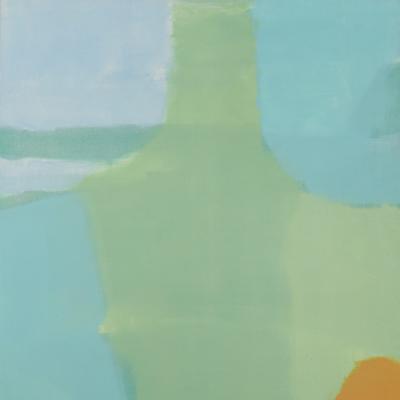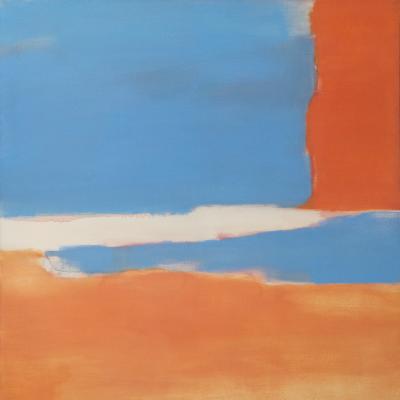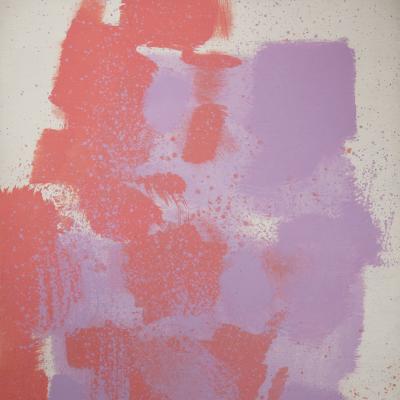-
 Carl HoltyFallow LightSigned lower left: HoltyOil on canvas59 x 38 inches
Carl HoltyFallow LightSigned lower left: HoltyOil on canvas59 x 38 inches
Framed: 59 1/2 x 39 3/4 inches -
 Carl HoltyAscendingSigned lower right: HoltyOil on canvas52 x 38 inches
Carl HoltyAscendingSigned lower right: HoltyOil on canvas52 x 38 inches -
 Carl HoltyDark BlueSigned lower left: HoltyOil on canvas48 x 35 inches
Carl HoltyDark BlueSigned lower left: HoltyOil on canvas48 x 35 inches -
 Carl HoltyDiagonal, 1967Signed lower right: HoltyOil on canvas60 x 48 1/4 inches
Carl HoltyDiagonal, 1967Signed lower right: HoltyOil on canvas60 x 48 1/4 inches
Framed: 62 x 50 1/4 inches -
 Carl HoltyMonument, Circa 1964Signed, dated, and dedicated versoOil on canvas60 x 46 inches
Carl HoltyMonument, Circa 1964Signed, dated, and dedicated versoOil on canvas60 x 46 inches -
 Carl HoltyMoving Red, 1963Signed lower right: Holty; signed, dated, and dedicated versoOil on canvas60 x 46 inches
Carl HoltyMoving Red, 1963Signed lower right: Holty; signed, dated, and dedicated versoOil on canvas60 x 46 inches
Framed: 62 x 48 inches
-
 Carl HoltyNara, 1966Signed lower right: HoltyOil on canvas67 x 58 inches
Carl HoltyNara, 1966Signed lower right: HoltyOil on canvas67 x 58 inches -
 Carl HoltyNorth by Northwest, 1960Signed lower right: Holty66 x 50 inches66 x 50 inches
Carl HoltyNorth by Northwest, 1960Signed lower right: Holty66 x 50 inches66 x 50 inches -
 Carl HoltyPink Sand, 1961Signed lower right; signed, dated, and dedicated versoOil on canvas48 x 36 inches
Carl HoltyPink Sand, 1961Signed lower right; signed, dated, and dedicated versoOil on canvas48 x 36 inches -
 Carl HoltySeparation, 1957Signed lower right: HoltyOil on canvas52 x 36 inches
Carl HoltySeparation, 1957Signed lower right: HoltyOil on canvas52 x 36 inches
Framed: 53 1/2 x 37 1/2 -
 Carl HoltyUntitled, 1948-49Signed lower rightOil on canvas20 x 24 in.
Carl HoltyUntitled, 1948-49Signed lower rightOil on canvas20 x 24 in.
Framed: 22 x 26 in. -
 Carl HoltyUntitled #116, 1963Signed lower left: Holty; signed, dated, and dedicated on stretcher versoOil on canvas60 x 46 inches
Carl HoltyUntitled #116, 1963Signed lower left: Holty; signed, dated, and dedicated on stretcher versoOil on canvas60 x 46 inches -
 Carl HoltyUntitled #158, 1957Signed lower right: Carl HoltyOil on canvas50 x 39 inches
Carl HoltyUntitled #158, 1957Signed lower right: Carl HoltyOil on canvas50 x 39 inches -
 Carl HoltyUntitled #1600Oil on canvas68 x 42 inches
Carl HoltyUntitled #1600Oil on canvas68 x 42 inches
Framed: 70 x 44 1/2 inches -
 Carl HoltyUntitled #58 (Red, Purple, White), 1970Signed lower left: HoltyOil on canvas40 x 30 inches
Carl HoltyUntitled #58 (Red, Purple, White), 1970Signed lower left: HoltyOil on canvas40 x 30 inches
Framed: 42 1/4 x 32 inches -
 Carl HoltyWhite Driftwood, 1952Oil on canvas52 x 44 inches
Carl HoltyWhite Driftwood, 1952Oil on canvas52 x 44 inches
Framed: 56 1/2 x 48 1/2 inches -
 Carl HoltyGray Volume in Red, 1968Signed lower right: HoltyOil on canvas66 x 52 1/4 inches
Carl HoltyGray Volume in Red, 1968Signed lower right: HoltyOil on canvas66 x 52 1/4 inches
Framed: 68 x 54 1/2 inches -
 Carl HoltyUntitled (Red, Gray) #5, Circa 1969Oil on canvas60 x 50 inches
Carl HoltyUntitled (Red, Gray) #5, Circa 1969Oil on canvas60 x 50 inches
Framed: 62 x 52 inches
Overview
Expressive forms; striking color. The vivid paintings of Carl Holty capture the sublime transcendence of the Color Field movement with a finesse that few other Abstract Expressionists were able to achieve. From his post-Cubist 1950s pieces to his floating '70s compositions, Holty pushed the boundaries of nonrepresentation.
The German-born American Abstractionist Carl Robert Holty (1900-1973) became known for his biomorphic abstract forms and geometric abstractions. Indelibly linked to both the Abstract Expressionist and Geometric Abstractionist art movements, Holty was a major proponent of Modernism in the United States and was a contributory influence to the world of American painting. He was a member of the Abstraction-Création Group in Paris, as well as a founding member of the American Abstract Artists. By the 1960s, Holty was creating paintings dominated by large color fields rendered with thinly washed fluid areas within subtly toned spaces, revealing the influences of Morris Louis and Helen Frankenthaler. A student of Hans Hofmann and his color theories of expanding dimensions and exuberant colors in abstractions, Holty created large, soft-edged color forms that were either mixed or floated on chromatic stains, experimenting with the relationship of space and form within a two-dimensional plane.






















